Fruit Rot:
Grapes infected with black rot turn brown, then harden into small, black, mummified berries. Brown rot of stone fruits causes whole fruit to turn brown and soft. Control fruit rots by planting resistant cultivars, removing and destroying infected fruit, and pruning to increase air movement. Applying compost tea or Bacillus subtilis may help prevent the disease from developing. Sulfur sprays throughout the season can be effective, too, as a last resort.
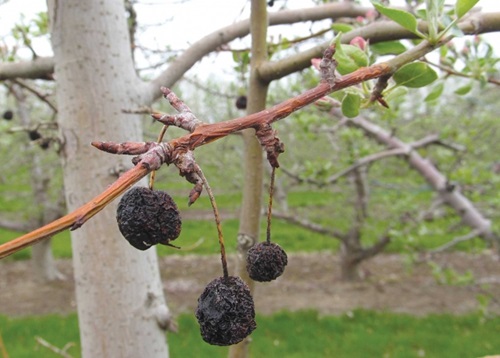
Rots:
Rots are diseases that decay roots, stems, wood, flowers, and fruit. Some diseases cause leaves to rot, but those symptoms tend to be described as leaf spots and blights. Rots can be soft and squishy or hard and dry. They are caused by various bacteria and fungi. Many are very active in stored fruits, roots, bulbs, or tubers.
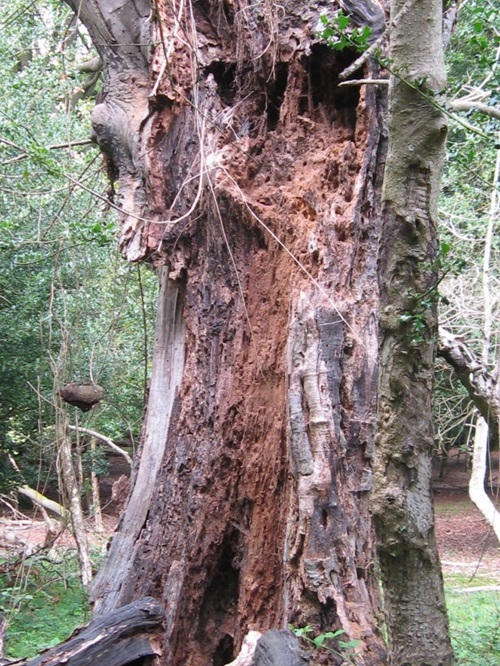
Scabs:
Scabs are fungal diseases that cause fruits, leaves, and tubers to develop areas of hardened, overgrown, and sometimes cracked tissue. Fruit scab can be a major problem on apples and peaches. Control by disposing of fallen leaves and pruning to increase air movement. If you’ve had past serious problems with scab, ask your local extension service about the best spray schedule for sulfur to control the disease.
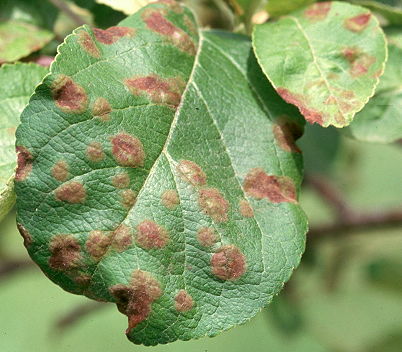
Molds:
Molds are characterized by a powdery or woolly appearance on the surface of the infected part.
Gray mold, or botrytis, is a common problem on many fruits and flowers. It thrives in moist conditions and is often seen on dropped flower petals or overripe fruit. It appears as a thick, gray mold or as water-soaked, blighted regions of petals, leaves, or stems. In most cases it first infects dead or dying tissue, so removing faded flowers and blighted buds or shoots will control the problem. Peonies, tulips, and lilies can be severely damaged in wet seasons. Destroy infected material, and space, prune, and support plants to encourage good air movement.
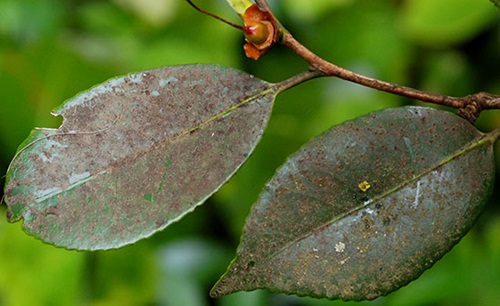
Galls:
Galls are swollen masses of abnormal tissue. They can be caused by fungi and bacteria as well as certain insects. If you cut open a gall and there is no sign of an insect, suspect disease.
Crown gall is a serious bacterial disease that infects and kills grapes, roses, fruit trees, brambles, shade trees, flowers, and vegetables. Galls are rounded with rough surfaces and are made up of corky tissue. They often occur on the stem near the soil line or graft union but can also form on roots or branches. To control it, buy healthy plants, and reject any suspicious ones. Don’t replant in an area where you have had crown gall. Avoid wounding stems, and disinfect tools between plants when pruning. Remove and destroy infected plants, or cut out galls.
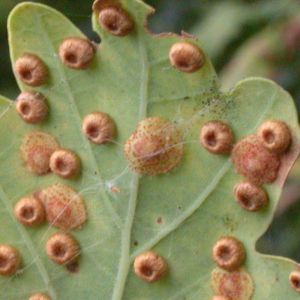
Mushroom or Wood Rots:
These rots can damage or kill trees. Some of them form obvious mushrooms or other fungal growths. Cutting out infected areas can provide control. Keep soil well drained, and plant resistant species and cultivars where problems are severe.
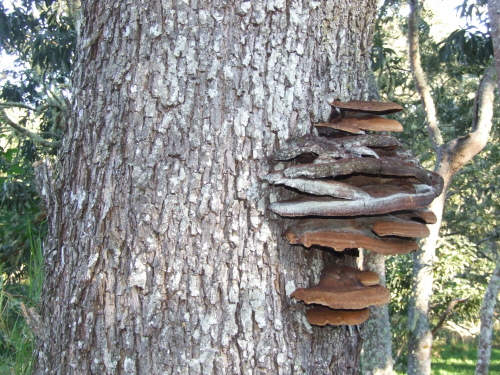
Nematodes:
Nematodes themselves are described earlier in this entry. Symptoms of nematode invasion include reduced growth, wilting, and lack of vigor.
Some nematodes cause excessive branching of roots, rotted roots, and enlarged lumps on roots. Other nematodes attack leaves, causing triangular wedges of dead tissue.
Root knot nematodes attack a variety of plant root systems, including most vegetable and ornamental crops. Carrot plants will be stunted, with yellowed leaves, and roots may be distorted. Roots of other plants will have swollen areas. Remember that legumes are supposed to have swellings on their roots that are caused by nitrogen-fixing bacteria.
Prevent nematodes from invading your plants by maintaining your soil organic matter. Plant resistant varieties when possible. Take care not to spread soil from nematode-infested areas to other parts of your garden or yard. Reduce nematode populations by solarizing soil. Use a marigold (Tagetes patula or T. erecta) cover crop to reduce nematodes. Rotate susceptible crops. Adding products containing chitin to the soil can help reduce problems.
Hot-water dips can eradicate nematodes from within roots, bulbs, and the soil on them.
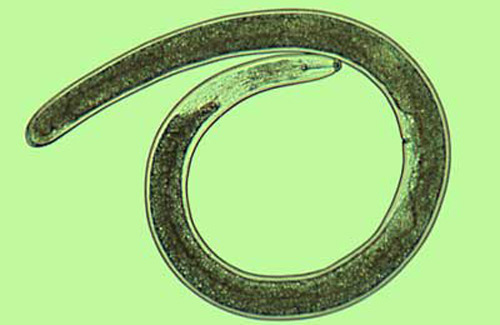
Viruses:
Infected plants often grow slowly and yield poorly. Leaves may cup or twist, and develop mottling, streaking, or ring-shaped spots. Identification is often the elimination of all other possible causes. Professional growers use heat treatments and tissue culture to control viral disease. Purchase certified plants to avoid problems. Control insects that spread viruses. Remove and burn all plants with viral disease to prevent the disease from spreading.
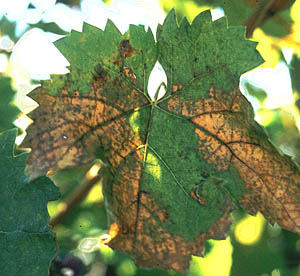
Scale:
You have scale, and the black on the leaves is the honey dew that is left behind as the insect moves throughout the plant.
Scale insects suck sap from plants, robbing them of essential nutrients. The armored and soft scale bug is the most destructive. Armored scales are more difficult to control once mature. Soft scale bugs excrete large amounts of honeydew, which enables the growth of sooty mold, a black-colored fungus that can stunt plant growth by blocking the process of photosynthesis. Mealybugs are easier to control with the proper program in place. Scales cannot fly, therefore, dispersal depends on the movement of crawlers. This year during winter scouting an abundance of all types of scale have been noticed due to the warm and dry fall/winter we have experienced. A systemic treatment should be done in the spring (End of March beginning of April) to treat as a preventative before warm weather brings the scales out of hibernation.
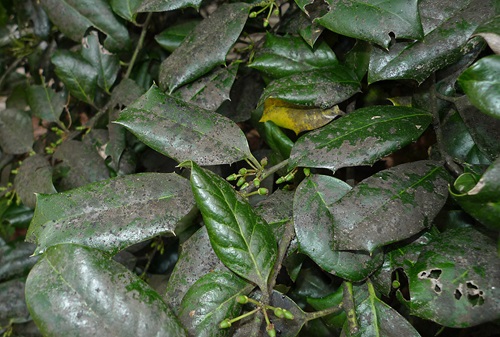
Leaf Spots:
A vast number of fungi can cause spots on the leaves of plants. Most of them are of little consequence. A typical spot has a definite edge and often has a darker border. When lots of spots are present, they can grow together and become a blight or a blotch.
Blackspot is a common disease on roses. The spots appear on the leaves and are up to 1/2 inch across with yellow margins. Severe cases cause leaves to drop. To control blackspot, plant resistant cultivars, and destroy all dropped leaves and prunings. Mulch to prevent dirt and spores from being splashed up onto plants. Bicarbonate sprays can be very helpful in preventing leaf spot diseases.

Powdery Mildew:
Mildews are one of the most widespread and easily recognized fungi. They are common on phlox, lilac, melons, cucumbers, and many other plants. Mildew forms a white to grayish powdery growth, usually on the upper surfaces of leaves. Small black dots appear and produce spores that are blown by wind to infect new plants. Leaves will become brown and shrivel when mildew is extensive. Fruits ripen prematurely and have poor texture and flavor. To control mildews, prune or stake plants to improve air circulation and dispose of infected plants before spores form. Apply bicarbonate sprays to prevent the spread of infection.
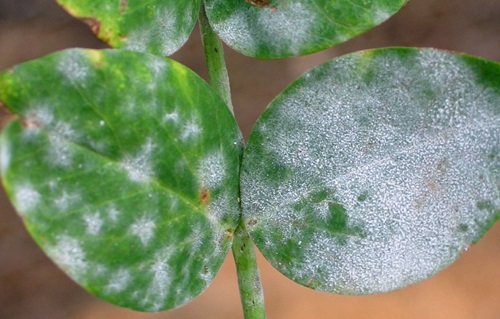
Downy Mildew:
Downy mildews are fungal diseases that attack many fruits, vegetables, flowers, and grasses. The primary symptom is a white to purple, downy growth, usually on the undersides of leaves and along stems, which turns black with age. Upper leaf surfaces have a pale color. Lima bean pods may be covered completely, while leaves are distorted. The disease overwinters on infected plant parts and remains viable in the soil for several years. It is spread by wind, by rain, and in seeds. To control it, buy disease-free seeds and plants, follow a 3-year rotation, and remove and dispose of infected plants. Preventive sprays of bicarbonate may be effective.
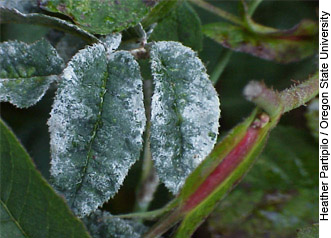
Leaf Blisters and Curls:
Leaf blister and leaf curl are fungal diseases that cause distorted, curled leaves on many trees. Oak leaf blister can defoliate and even kill oak trees. Blisters are yellow bumps on the upper surface of the leaves, with gray depressions on the lower surface. Peach leaf curl attacks peaches and almonds. New leaves are pale or reddish and the midrib doesn’t grow along with the leaves, so the leaves become puckered and curled as they expand. Fruit is damaged, and bad cases can kill the tree. Both diseases are controlled with a single dormant oil spray just before buds begin to swell.
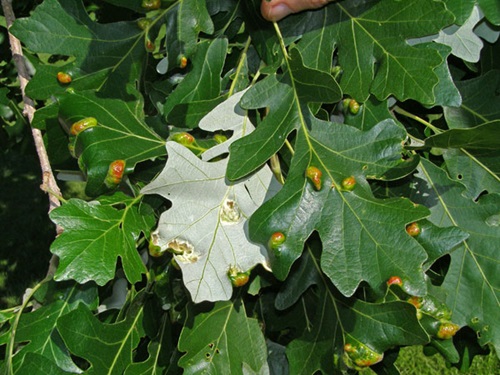
Viruses:
Infected plants often grow slowly and yield poorly. Leaves may cup or twist, and develop mottling, streaking, or ring-shaped spots. Identification is often the elimination of all other possible causes. Professional growers use heat treatments and tissue culture to control viral disease. Purchase certified plants to avoid problems. Control insects that spread viruses. Remove and burn all plants with viral disease to prevent the disease from spreading.

Moisture Imbalance:
Plants need a relatively constant supply of water. If they don’t have enough, they will wilt. Long periods of wilting, or repeated wilting, can cause stunting, pale color, and reduced flowering and fruit production. Plant roots also need oxygen. Too much water in the soil damages roots and will cause symptoms like frequent wilting, pale color, root decay, leaf dropping, and lack of vigor.
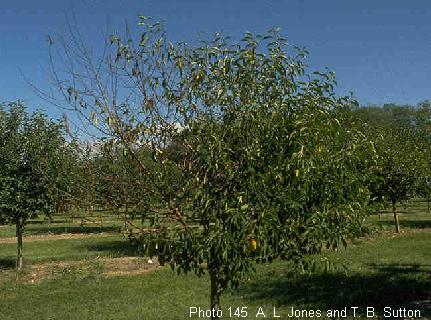
Wind Damage:
High winds also take their toll on plant appearance. Silvery discoloration and tattered leaves are symptoms of wind damage.
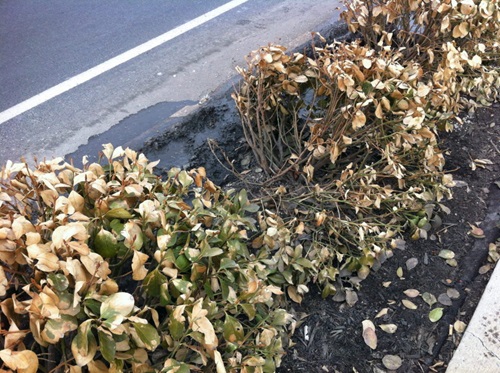
Cold Injury:
Freezing injury can cause death or dieback. Symptoms of cold stress are stunting, yellowing, bud or leaf drop, and stem cracking. Fruit may form a layer of corky tissue or be russeted if exposed to cold when young.
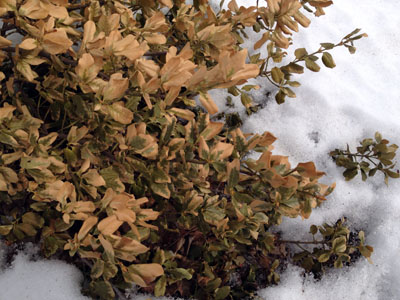
Scabs:
Scabs are fungal diseases that cause fruits, leaves, and tubers to develop areas of hardened, overgrown, and sometimes cracked tissue. Fruit scab can be a major problem on apples and peaches. Control by disposing of fallen leaves and pruning to increase air movement. If you’ve had past serious problems with scab, ask your local extension service about the best spray schedule for sulfur to control the disease.

Alternaria Blight (Early Blight):
This fungal blight infects ornamental plants, vegetables, fruit trees, and shade trees worldwide. On tomatoes, potatoes, and peppers, it is called early blight. On leaves, brown to black spots form and enlarge, developing concentric rings. Heavily blighted leaves dry up and die as spots grow together. Lower leaves usually show symptoms first. Targetlike, sunken spots will develop on tomato branches and stems. Fruits and potato tubers also develop dark, sunken spots. Alternaria spores are carried by air currents and are common in dust and air everywhere. They are a common cause of hay fever allergies. Alternaria fungi overwinter on infected plant parts and debris, or in or on seeds. Control this disease by planting resistant cultivars and growing your own transplants from disease-free seed. Apply Trichoderma harzianum to the soil just before planting. Promote good air circulation. For early blight, apply potassium bicarbonate (baking soda) sprays starting 2 weeks before the time of year when symptoms would normally first appear. Dispose of infected plants and when possible, use a 3-year rotation.
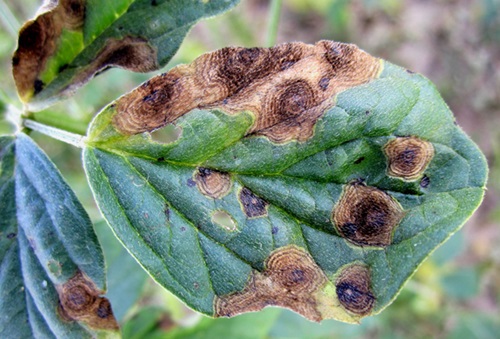
Blights:
When plants suffer from blight, leaves or branches suddenly wither, stop growing, and die. Later, plant parts may rot.
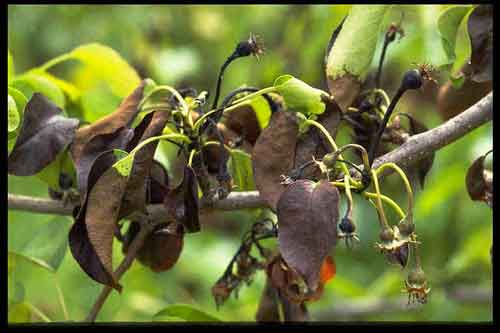
Heat Injury:
Temperatures that are too high cause sunscald of fruits, leaves, or trunks on the sunny side of the plant. Discoloration, blistering, or a water-soaked and sunken appearance are other symptoms of heat stress.
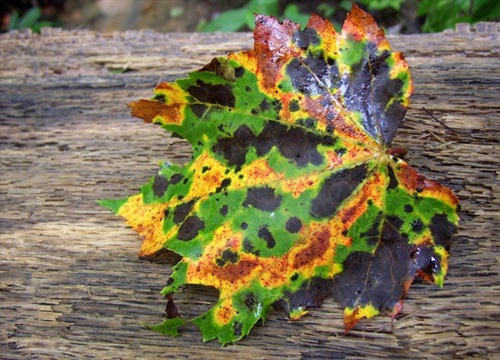
Smuts:
Smuts are fungal diseases. They are most commonly seen on grasses, grains, and corn. Enlarged galls are soft and spongy when young but change to a dark, powdery mass as they age.
Corn smut can form on kernels, tassels, stalks, and leaves. Smut galls ripen and rupture, releasing spores that travel through the air to infect new plants and overwinter in the soil, awaiting future crops. To control corn smut, select resistant cultivars. Remove and burn galls before they break open, and follow a 4-year rotation.
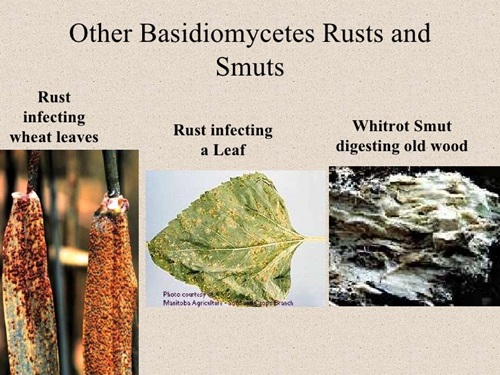
Molds:
Molds are characterized by a powdery or woolly appearance on the surface of the infected part.
Gray mold, or botrytis, is a common problem on many fruits and flowers. It thrives in moist conditions and is often seen on dropped flower petals or overripe fruit. It appears as a thick, gray mold or as water-soaked, blighted regions of petals, leaves, or stems. In most cases it first infects dead or dying tissue, so removing faded flowers and blighted buds or shoots will control the problem. Peonies, tulips, and lilies can be severely damaged in wet seasons. Destroy infected material, and space, prune, and support plants to encourage good air movement.

Leaf Spots:
A vast number of fungi can cause spots on the leaves of plants. Most of them are of little consequence. A typical spot has a definite edge and often has a darker border. When lots of spots are present, they can grow together and become a blight or a blotch.
Blackspot is a common disease on roses. The spots appear on the leaves and are up to 1/2 inch across with yellow margins. Severe cases cause leaves to drop. To control blackspot, plant resistant cultivars, and destroy all dropped leaves and prunings. Mulch to prevent dirt and spores from being splashed up onto plants. Bicarbonate sprays can be very helpful in preventing leaf spot diseases.

Anthracnose:
Anthracnose, or bird’s-eye spot, is a fungal disease. It causes small dead spots that often have a raised border and a sunken center, and that may have concentric rings of pink and brown.
Bean anthracnose infects beans and other legumes. The symptoms are most obvious on the pods as circular, black, sunken spots that may ooze pink slime and develop red borders as they age. To control, buy disease-free seed, rotate crops, turn under or hot-compost infected plants, and avoid touching plants when they are wet so you won’t spread the disease.
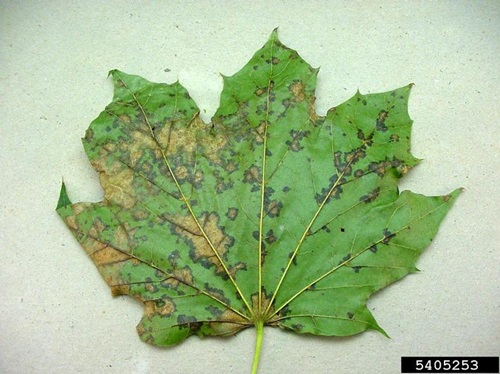
Asparagus Rust:
This disease appears as a browning or reddening of the small twigs and needles, and a release of rusty, powdery spores. It overwinters on stalks and infects new shoots as they emerge the following spring. Rust is also carried to other plants by wind. To control, space plants to allow air circulation. Plant resistant cultivars. Remove infected plants and burn them in fall.
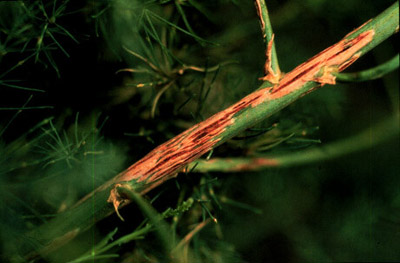
Rusts:
Rusts are a specific type of fungal disease. Many of them require two different plant species as hosts to complete their life cycle. Typical rust symptoms include a powdery tan to rust-colored coating. Applying neem oil can help prevent rust by killing spores on the leaves.
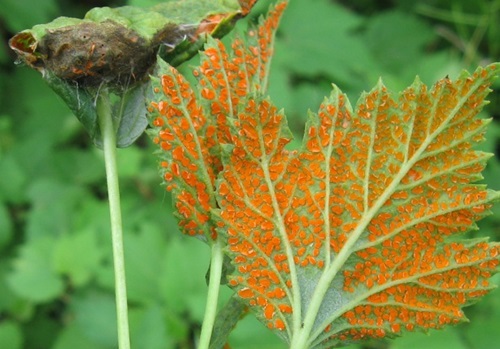
Bacterial Blight:
This bacterial disease is particularly severe on legumes in eastern and southern North America. Foliage and pods display water-soaked spots that dry and drop out. On stems, lesions are long and dark colored. Some spots may ooze a bacterial slime. To control, plant resistant cultivars, remove infected plants, and dispose of plant debris. Use a 3-year rotation and don’t touch plants while they are wet, as you may spread the disease.

Damping-off:
Damping-off is caused by a variety of soilborne fungi. Seeds rot before they germinate, or seedlings rot at the soil line and fall over. It can be a problem with indoor seedlings and also in garden beds. Prevent damping-off by keeping soil moist, but not waterlogged. Provide good air movement in seed-starting areas. Wait until soil is warm enough for the specific plant before seeding. Sterile seed-starting mix or a mix that includes compost can help prevent problems, too. If you’ve had past problems with this disease, add compost to your soil, and use a product containing Trichoderma harzianum to drench the soil before planting.
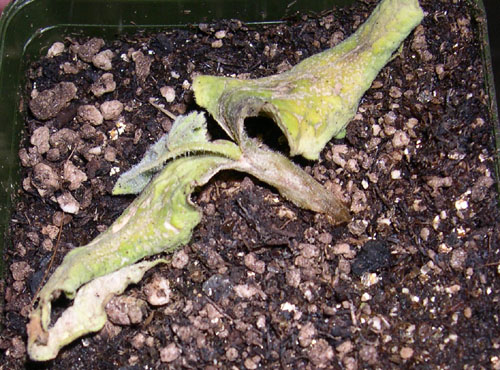
Wood Borers:
Borer infestations often go unnoticed until plants or parts of plants begin to die or show external signs of damage. Wood-boring insects often produce sawdust-like frass (excrement). Their holes are normally round, oval or semicircular and are found in a random pattern on the plant. Woodpecker damage is sometimes confused with that of wood-boring beetles; however woodpecker damage will not produce frass. One woodpecker, the yellow-bellied sapsucker, produces square holes in rows around a trunk or branch.
Many borers damage plants by tunneling through the inner bark layer (cambium) into the sapwood (xylem) that transports nutrients and water to the leaves. These insects are called phloem feeders. When the cambium layer is completely girdled the plant eventually dies above or beyond the damage site. Partial girdling reduces plant growth and vigor above the site of attack. On occasion, tunneling makes the tree weak, causing limbs and branches to fall. Borer damage can severely affect the quality of lumber and can make trees susceptible to disease.
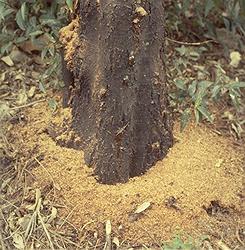
Dieback of shoots and stem cankers develop on lilacs, rhododendrons, azaleas, and holly
Phytophthora Blight (Late Blight):
Lilacs, rhododendrons, azaleas, and holly infected by Phytophthora fungi suffer dieback of shoots and develop stem cankers. Prune to remove infected branches and to increase air movement.
On peppers, potatoes, and tomatoes, Phytophthora infection is known as late blight. The first symptom is water-soaked spots on the lower leaves. The spots enlarge and are mirrored on the undersurface of the leaf with a white downy growth. Dark-colored blotches penetrate the flesh of tubers. These spots may dry and appear as sunken lesions. During a wet season, plants will rot and die. The pathogen overwinters on infected tubers and in plant debris. Avoid problems by planting only in well-drained soil, and use resistant varieties if possible. For late blight, keep foliage dry as much as possible, and check frequently for symptoms whenever the weather is wet. Preventive sprays of compost tea or Bacillus subtilis may help prevent the disease. Immediately remove and destroy plants infected with late blight; prune off cankered shoots of shrubs. After harvest, remove and destroy all plant debris that may be infected.
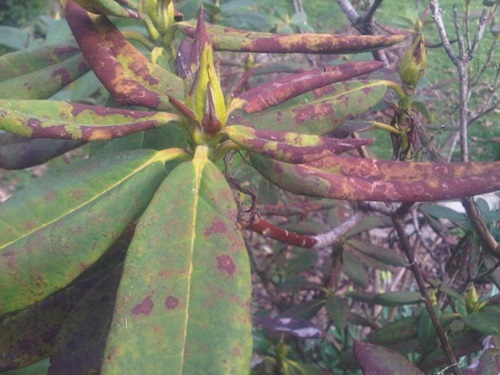
Root and Stem Rots:
Control these troublesome rots by providing good drainage and good air circulation. Try drenching the soil with beneficial fungi or bacteria. Start cuttings in sterilized mix, and plant only healthy plants. Dispose of all infected plant material. Winter injury may invite problems on woody plants.
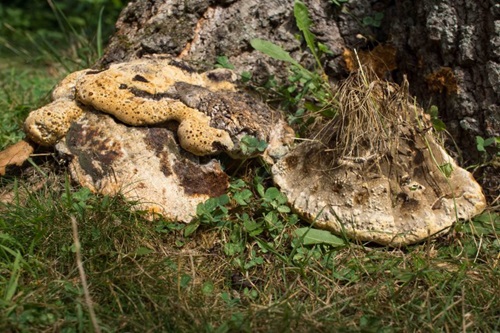
Rots:
Rots are diseases that decay roots, stems, wood, flowers, and fruit. Some diseases cause leaves to rot, but those symptoms tend to be described as leaf spots and blights. Rots can be soft and squishy or hard and dry. They are caused by various bacteria and fungi. Many are very active in stored fruits, roots, bulbs, or tubers.

Cankers:
Cankers usually form on woody stems and may be cracks, sunken areas, or raised areas of dead or abnormal tissue. Sometimes cankers ooze conspicuously. Cankers can girdle shoots or trunks, causing everything above the canker to wilt and die. Blights and diebacks due to cankers look quite similar. Cold-injury symptoms may look like, or lead to the development of, cankers and diebacks.
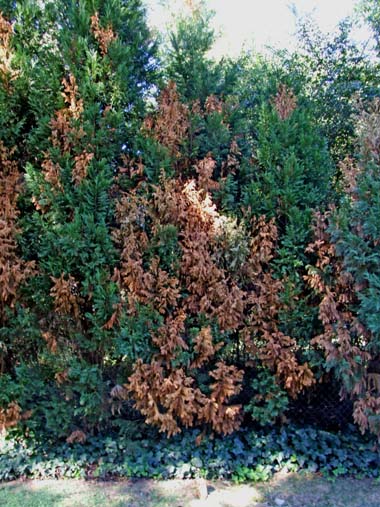
Downy Mildew:
Downy Mildew: Downy mildews are fungal diseases that attack many fruits, vegetables, flowers, and grasses. The primary symptom is a white to purple, downy growth, usually on the undersides of leaves and along stems, which turns black with age. Upper leaf surfaces have a pale color. Lima bean pods may be covered completely, while leaves are distorted. The disease overwinters on infected plant parts and remains viable in the soil for several years. It is spread by wind, by rain, and in seeds. To control it, buy disease-free seeds and plants, follow a 3-year rotation, and remove and dispose of infected plants. Preventive sprays of bicarbonate may be effective.

Cold Injury:
Freezing injury can cause death or dieback. Symptoms of cold stress are stunting, yellowing, bud or leaf drop, and stem cracking. Fruit may form a layer of corky tissue or be russeted if exposed to cold when young.

Fire Blight:
This bacterial disease affects apples, pears, fruit trees, roses, and small fruits. Infected shoots wilt and look blackened.
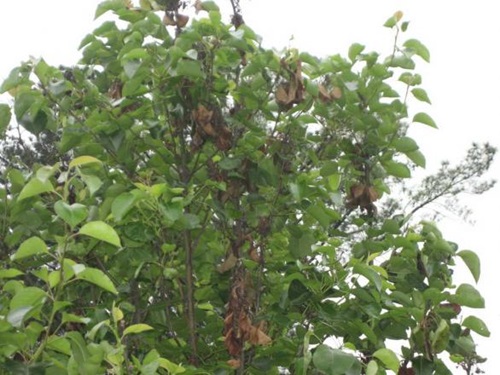
Club Root:
Club root affects vegetables and flowers in the cabbage family. Plants infected by the fungus wilt during the heat of the day, and older leaves yellow and drop. Roots are distorted and swollen. Avoid club root by choosing resistant cultivars and raising your own seedlings. The fungus has spores that can persist in soil for many years. If you’ve had past club root problems, adjust the soil pH to at least 6.8 before planting susceptible crops.
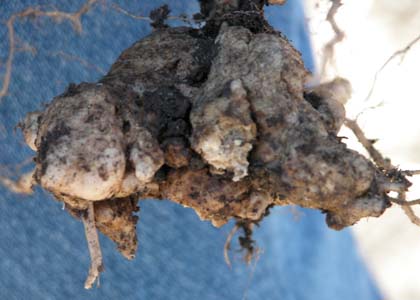
Fusarium and Verticillium Wilt:
These fungal wilts attack a wide range of flowers, vegetables, fruits, and ornamentals. Plants wilt and may turn yellow. To control, plant resistant cultivars. Rotate crops, or do not replant in areas where problems have occurred. If wilt only affects a branch, it may help to cut it out well below the wilt symptoms. Destroy infected branches or plants.

Stewart’s Wilt:
This bacterial disease is widespread on sweet corn in eastern North America. It overwinters in flea beetles and infects corn when they begin feeding on its leaves. Infected leaves wilt and may have long streaks with wavy margins. Bacterial slime will ooze out if the stalks or leaves are cut. Plants eventually die or are sufficiently stunted that no ears are produced. To control, plant resistant cultivars and eliminate flea beetles. Destroy infected plants.
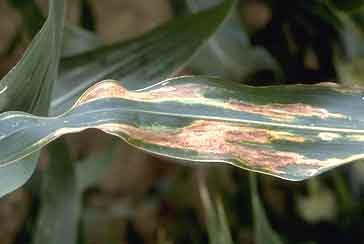
Wilts:
Plants wilt when they don’t get enough water. When fungi or bacteria attack or clog a plant’s water-conducting system, they can cause permanent wilting, often followed by the death of all or part of the plant. Wilt symptoms may resemble those of blights.
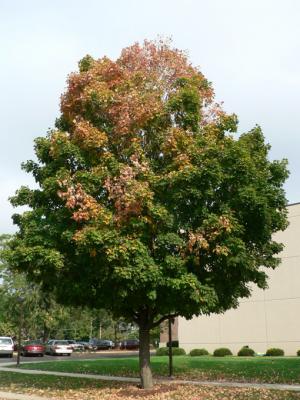
Moisture Imbalance:
Plants need a relatively constant supply of water. If they don’t have enough, they will wilt. Long periods of wilting, or repeated wilting, can cause stunting, pale color, and reduced flowering and fruit production. Plant roots also need oxygen. Too much water in the soil damages roots and will cause symptoms like frequent wilting, pale color, root decay, leaf dropping, and lack of vigor.




